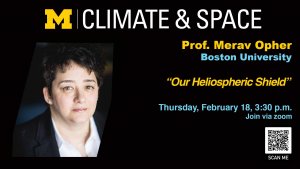Presented By: Climate and Space Sciences and Engineering
CLASP Seminar Series: Prof. Merav Opher

Prof. Merav Opher of Boston University will give a virtual lecture as part of the CLASP Seminar Series.
This is a Zoom virtual event.
https://umich.zoom.us/j/91268753609?pwd=d3JXTnpwZ00wUmpLaFpLaDkvVDdBdz09
Meeting ID: 912 6875 3609
Passcode: 068208
"Our Heliospheric Shield"
ABSTRACT:
Astrospheres shield stars and their systems of planets from energetic particles called galactic cosmic rays (GCRs) that stream from the galaxy. The shielding of GCRs by astrospheres is a fundamental, open question whose answer is critical to assessing the habitability of exoplanets. But even before we study the shielding properties of other astrospheres to ascertain habitability, we must understand why the only known astrosphere that harbors life, Earth’s Sun’s heliosphere, does so. Space science is at a pivotal point in generating new understandings of the heliosphere due to the flood of new in situ data from the Voyager 1 (V1), Voyager 2 (V2), and New Horizon spacecraft, combined with the energetic neutral atom (ENA) maps generated by IBEX and Cassini. To date, our best large-scale computer models fail to reproduce critical observations, such as the size of the heliosphere, the plasma speeds and directions, and the width of the heliosheath.
Heliospheric observations indicate that processes such as turbulence, reconnection, wave-particle interactions and thermal conduction play a crucial role in the outer layers of the solar system; however, these processes have not yet been included in current global models. Observations by Voyager indicate that suprathermal particles, such as pickup ions (PUIs, ionized particles formed from the interaction of the ionized solar wind with the neutral interstellar H atoms), carry most of the plasma pressure in outer layers of the solar system. How these suprathermal populations evolve in response to kinetic effects, such as turbulence, reconnection and acceleration, is poorly understood, but given their energy contribution they significantly impact global scales. Other remaining puzzles are: 1) The acceleration region and mechanism for anomalous cosmic rays (ACRs); the two Voyager spacecraft found no evidence of acceleration of high-energy ACRs at the termination shock (TS) but instead detected their increase of the ACRs as they moved across the heliosheath (HS). 2) The HS 30-50% thinner than current models predict 3) The magnetic field direction doesn’t change at the HP and we don’t know how far from the HP does the solar wind influence extend 4) The significant increase in Galactic Cosmic Rays (GCRs) just prior to the HP crossings by both V1 and V2, and the unusual anisotropies observed in the LISM are not understood.
In this talk I will review some of the puzzles and advances being made in understanding some of the fundamental features of the heliosphere as well as the efforts being made in that regard by the SHIELD DRIVE Science Center (http://sites.bu.edu/shield-drive/). These aspects include the basic “shape” of the heliosphere, the extent of its tail, the nature of the heliosheath, and the structure of the local interstellar medium (LISM) just upstream of the heliopause (HP).
Please join us!
This is a Zoom virtual event.
https://umich.zoom.us/j/91268753609?pwd=d3JXTnpwZ00wUmpLaFpLaDkvVDdBdz09
Meeting ID: 912 6875 3609
Passcode: 068208
"Our Heliospheric Shield"
ABSTRACT:
Astrospheres shield stars and their systems of planets from energetic particles called galactic cosmic rays (GCRs) that stream from the galaxy. The shielding of GCRs by astrospheres is a fundamental, open question whose answer is critical to assessing the habitability of exoplanets. But even before we study the shielding properties of other astrospheres to ascertain habitability, we must understand why the only known astrosphere that harbors life, Earth’s Sun’s heliosphere, does so. Space science is at a pivotal point in generating new understandings of the heliosphere due to the flood of new in situ data from the Voyager 1 (V1), Voyager 2 (V2), and New Horizon spacecraft, combined with the energetic neutral atom (ENA) maps generated by IBEX and Cassini. To date, our best large-scale computer models fail to reproduce critical observations, such as the size of the heliosphere, the plasma speeds and directions, and the width of the heliosheath.
Heliospheric observations indicate that processes such as turbulence, reconnection, wave-particle interactions and thermal conduction play a crucial role in the outer layers of the solar system; however, these processes have not yet been included in current global models. Observations by Voyager indicate that suprathermal particles, such as pickup ions (PUIs, ionized particles formed from the interaction of the ionized solar wind with the neutral interstellar H atoms), carry most of the plasma pressure in outer layers of the solar system. How these suprathermal populations evolve in response to kinetic effects, such as turbulence, reconnection and acceleration, is poorly understood, but given their energy contribution they significantly impact global scales. Other remaining puzzles are: 1) The acceleration region and mechanism for anomalous cosmic rays (ACRs); the two Voyager spacecraft found no evidence of acceleration of high-energy ACRs at the termination shock (TS) but instead detected their increase of the ACRs as they moved across the heliosheath (HS). 2) The HS 30-50% thinner than current models predict 3) The magnetic field direction doesn’t change at the HP and we don’t know how far from the HP does the solar wind influence extend 4) The significant increase in Galactic Cosmic Rays (GCRs) just prior to the HP crossings by both V1 and V2, and the unusual anisotropies observed in the LISM are not understood.
In this talk I will review some of the puzzles and advances being made in understanding some of the fundamental features of the heliosphere as well as the efforts being made in that regard by the SHIELD DRIVE Science Center (http://sites.bu.edu/shield-drive/). These aspects include the basic “shape” of the heliosphere, the extent of its tail, the nature of the heliosheath, and the structure of the local interstellar medium (LISM) just upstream of the heliopause (HP).
Please join us!